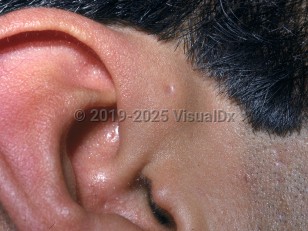Preauricular sinus in Adult
Alerts and Notices
Important News & Links
Synopsis

Preauricular sinuses are common congenital abnormalities that manifest as small invaginations adjacent to the external ear, near the anterior margin of the ascending limb of the helix.
Preauricular sinuses arise during embryogenesis. One theory proposes that they may result from defective fusion of the 6 auricular hillocks that arise from the first and second branchial arches. These malformations may be sporadic or inherited in an incomplete autosomal dominant fashion, with reduced penetrance and variable expression. When inherited, they are more likely to be present bilaterally. The incidence varies by geographic location: 0.1%-0.9% in the United States, 1.6%-2.5% in Taiwan, and up to 4%-10% in some parts of Africa. Associated conditions include deafness and branchio-oto-renal syndrome.
The sinus tracts are typically narrow and short; usually, the duct connects to the perichondrium of the auricular cartilage. Preauricular sinuses are typically asymptomatic.
There are 2 similar congenital abnormalities that occur in this location as a result of the same embryogenic events: A preauricular pit is a superficial dell that does not have a deeper component, and a preauricular cyst is a cyst lined by stratified squamous epithelium that extends from a preauricular sinus.
Preauricular sinuses and cysts may present with discharge, either because of desquamating epithelial debris or as a sign of infection, most commonly with gram-positive organisms. Other signs of infection include erythema, swelling, and pain. Infection can lead to abscess formation.
Preauricular sinuses arise during embryogenesis. One theory proposes that they may result from defective fusion of the 6 auricular hillocks that arise from the first and second branchial arches. These malformations may be sporadic or inherited in an incomplete autosomal dominant fashion, with reduced penetrance and variable expression. When inherited, they are more likely to be present bilaterally. The incidence varies by geographic location: 0.1%-0.9% in the United States, 1.6%-2.5% in Taiwan, and up to 4%-10% in some parts of Africa. Associated conditions include deafness and branchio-oto-renal syndrome.
The sinus tracts are typically narrow and short; usually, the duct connects to the perichondrium of the auricular cartilage. Preauricular sinuses are typically asymptomatic.
There are 2 similar congenital abnormalities that occur in this location as a result of the same embryogenic events: A preauricular pit is a superficial dell that does not have a deeper component, and a preauricular cyst is a cyst lined by stratified squamous epithelium that extends from a preauricular sinus.
Preauricular sinuses and cysts may present with discharge, either because of desquamating epithelial debris or as a sign of infection, most commonly with gram-positive organisms. Other signs of infection include erythema, swelling, and pain. Infection can lead to abscess formation.
Codes
ICD10CM:
Q18.1 – Preauricular sinus and cyst
SNOMEDCT:
204272007 – Preauricular fistula
Q18.1 – Preauricular sinus and cyst
SNOMEDCT:
204272007 – Preauricular fistula
Look For
Subscription Required
Diagnostic Pearls
Subscription Required
Differential Diagnosis & Pitfalls

To perform a comparison, select diagnoses from the classic differential
Subscription Required
Best Tests
Subscription Required
Management Pearls
Subscription Required
Therapy
Subscription Required
References
Subscription Required
Last Reviewed:04/16/2020
Last Updated:04/16/2020
Last Updated:04/16/2020
Preauricular sinus in Adult

